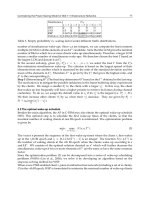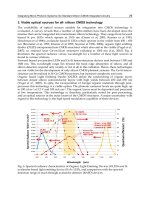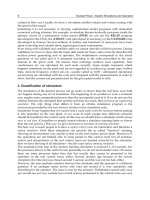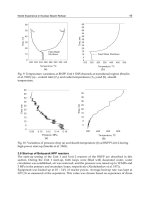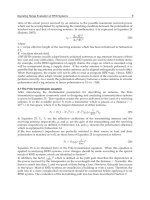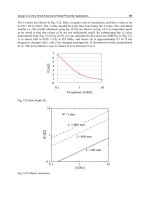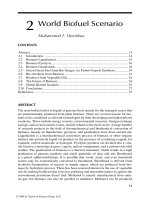Aluminium Design and Construction - Chapter 2 potx
Bạn đang xem bản rút gọn của tài liệu. Xem và tải ngay bản đầy đủ của tài liệu tại đây (357.45 KB, 17 trang )
CHAPTER 2
Manufacture
In this chapter we describe the manufacture of wrought aluminium
products, such as plate, sheet, sections and tube, known in the trade
as semi-fabricated products (or ‘semi-fabs’). The two main stages are
production of pure aluminium ingot, and conversion of this into wrought
material.
2.1 PRODUCTION OF ALUMINIUM METAL
2.1.1 Primary production
The production of aluminium ingot comprises three steps: (1) mining
the bauxite ore; (2) extracting alumina therefrom; and (3) smelting.
Bauxite is plentiful in many countries and is extracted by opencast
mining. Alumina (A1
2
O
3
), a white powder, is obtained from bauxite by
the Bayer process which requires a large supply of coal and caustic
soda. Roughly 2 kg of bauxite, 2 kg of coal and 0.5 kg of caustic soda
are needed to produce 1 kg of alumina.
In the smelting operation, metallic aluminium is extracted from alumina
by electolysis, using the Hall-Héroult process. It takes place in a cell (or
‘pot’) comprising a bath of molten cryolite (the electrolyte) and carbon
electrodes. A typical pot is around 4 or 5 m long. The cathode covers
the floor of the bath, while the anodes are in the form of massive
carbon blocks which are gradually lowered into the cryolite as they
burn away.
Alumina is fed in at the top of the molten pool, where it dissolves,
and molten aluminium is drawn off from the bottom. The metal emerges
at a temperature of around 900°C and at a high purity (99.5–99.8%).
Copious fumes are produced. The electric supply is direct current at a
typical potential of 5 V per pot, the current requirement being high,
around 100–150 kA. Continual replacement of the carbon anodes is also
a significant factor. The production of one kilo of aluminium consumes
roughly 2 kg of alumina, 0.5 kg of carbon and 15 kWh of electrical
energy. The cryolite (Na
3
AlF
6
) is largely unconsumed.
Copyright 1999 by Taylor & Francis Group. All Rights Reserved.
The main requirements for the production of aluminium are thus
bauxite, coal and cheap electricity. These are never all found in one
place. The location usually preferred for a smelter is near a dedicated
hydroelectric power plant, which may be thousands of kilometres from
the alumina source and from markets for the ingot, as, for example,
with the Kitemat smelter in British Columbia, Canada. Sometimes a
smelter is designed for strategic reasons to run on coal-fired electricity.
The new 50 000 tonne/yr smelter at Richards Bay in Natal, South Africa,
which relies on coal-fired electricity, has a total of nearly 600 pots contained
in four ‘potrooms’ each 900 m long×30 m wide.
2.1.2 Secondary metal
Not all the metal going into aluminium products comes from ingot, an
important ingredient being ‘secondary metal’, i.e. scrap. This is partly
supplied by scrap merchants, and partly comes from process scrap
generated in the rolling mill or extrusion plant. The composition of
such scrap is important, the best scrap being pure aluminium or a low
alloy. Melted-down airframe material is less convenient, as it contains
a relatively large amount of copper or zinc, making it less suitable for
making non-aeronautical alloys.
2.2 FLAT PRODUCTS
2.2.1 Rolling mill practice
Aluminium plate and sheet are manufactured in conventional rolling
mills, the main difference from steel being the lower temperatures
involved.
Alloyed metal is produced by melting a mixture of ingot and scrap,
to which are added metered quantities of ‘hardeners’ (small aluminium
ingots containing a high concentration of alloying ingredient). Rolling
slabs are then produced by vertical continuous casting in a long length,
from which individual slabs are cut. Each slab is skimmed on both
faces and slowly heated in a furnace, from which it enters the hot-line.
This might typically comprise a hot mill followed by a three-stand
tandem set-up. The material emerging therefrom, called ‘hot-mill strip’,
can be shipped directly as plate or reduced further in a cold mill to
produce sheet. The immediate output from the cold mill is coiled strip,
which is decoiled and cut into sheets. Plate and sheet widths thus produced
are typically about 1.5 m, although greater sizes are possible.
Copyright 1999 by Taylor & Francis Group. All Rights Reserved.
2.2.2 Plate
The term ‘plate’ refers to hot-rolled flat material, typically with a thickness
у
6 mm, although it may be thinner. When in a non-heat-treatable
alloy, plate is often supplied in the rather vague ‘as-hot-rolled’ or F
condition, for which only typical properties can be quoted. Alternatively
it may be annealed after rolling, bringing it to the O condition, in which
case the strength is lower but clearly specified. It is also possible for
non-heat-treatable plate to be rolled to a temper (i.e. specific hardness),
although this can be difficult to control on the hot-line.
Heat-treatable plate (2xxx, 6xxx or 7xxx-series alloy) is usually supplied
in the fully-heat-treated T6-condition, which involves a quenching process
followed by artificial ageing. Alternatively it can be produced in the
more ductile T4-condition, when it is allowed to age naturally at room
temperature.
2.2.3 Sheet
By ‘sheet’ we generally refer to flat material up to 6 mm thick (although
in the USA the term ‘shate’ is sometimes used for material on the border-
line between sheet and plate). It is produced by cold reduction, which
usually involves several passes with interpass annealing. Readily available
thicknesses are 0.5, 0.6, 0.8, 1.0, 1.2, 1.5, 2.0, 2.5, 3.0, 4.0, 5.0 and 6.0 mm.
Most sheet is produced in non-heat-treatable material (1xxx, 3xxx,
5xxx), and is supplied in a stated temper (such as ‘quarter-hard’, ‘half-
hard’) with specified mechanical properties. These are achieved by a
controlled sequence of rolling reductions, possibly with interpass
annealing. The sheet may be temper rolled, in which case it is given a
precise reduction after the last anneal. Or it may be temper annealed,
when the final stage is a suitably adjusted anneal after the last rolling
pass.
For more highly stressed applications, sheet is supplied in heat-treatable
alloy (2xxx, 6xxx or 7xxx series), usually in the fully-heat-treated T6-
condition (quenched and artificially aged).
2.2.4 Tolerance on thickness
The thickness tolerance t for flat products allows for variation across
the width, as well as for inaccuracy in the main thickness. Its value
depends on the thickness t and width w, and may be estimated
approximately from the following expressions:
Plate t=±(0.0000 14 wt+0.3) mm (2.1)
Sheet t=±(0.11 t+0.00004 w–0.06) mm (2.2)
Copyright 1999 by Taylor & Francis Group. All Rights Reserved.
in which t and w are in mm. These agree reasonably with the BSEN.485
requirements for t=1–30 mm and w > 1000 mm. Outside these ranges,
they overestimate the tolerance.
2.2.5 Special forms of flat product
(a) Clad sheet
Sheet material in 2xxx-series alloy, and also in the stronger type of
7xxx, can be produced in a form having improved corrosion resistance
by cladding it with a more durable layer on each surface. Such a product
is achieved by inserting plates of the cladding material top and bottom
of the slab as it enters the hot-mill. As rolling proceeds, these weld on
and are steadily reduced, along with the core, the proportion of the
total thickness being about 5% per face. For 2xxx-series sheet, the cladding
is in pure aluminium, while for the 7xxx an Al–1% Zn alloy is preferred.
(b) Treadplate
Aluminium treadplate is available with an anti-slip pattern rolled into
one surface, as in steel. It is normally supplied in the stronger type of
6xxx-series alloy in the T6-condition.
(c) Profiled sheeting
This product, which can be used for many sorts of cladding, is made by
roll-forming. An important use is for the cladding of buildings, where
a trapezoidal profile is usually specified, formed from hard-rolled sheet
in 3xxx-series alloy. Some such profiles are of ingenious ‘secret-fix’ design.
(d) Embossed sheet
This is sheet having a degree of roughening (of random pattern) rolled
into one surface. It can be used in order to reduce glare. It is also
claimed to improve the stiffness slightly. Such sheet is sometimes employed
in the manufacture of profiled sheeting.
(e) Cold-rolled sections
As in steel, it is possible to produce small sections by roll-forming from
strip. However, the technique is not generally favoured for aluminium,
because extrusion has more advantages. But it comes into its own for
very thin sections, of thickness less than the minimum extrudable, say,
1 mm and under.
Copyright 1999 by Taylor & Francis Group. All Rights Reserved.
2.3 EXTRUDED SECTIONS
2.3.1 Extrusion process
Although available for some other non-ferrous metals, such as brass
and bronze, it is with aluminium that the extrusion process has become
a major manufacturing method, far more so than with any other metal
[7]. This is partly due to the relatively low temperature at which the
metal will extrude (roughly 500°C).
The process enables aluminium sections to be produced from 10 to
800 mm wide, with an unlimited range of possible shapes. The tool cost
for producing a new section is a minute fraction of that for a new section
in steel, as it merely involves cutting a new die. Also, the down-time at
the press for a die change is negligible compared to the time lost for a
roll change in the steel mill. In aluminium, it is therefore common practice
to design a special dedicated section to suit the job in hand, or a ‘suite’
of such sections, and the quantities do not have to be astronomic to make
this worthwhile. An important feature of aluminium extrusion is the
ability to produce sections that are very thin relative to their overall size.
There are various versions of the extrusion process. Aluminium sections
are normally produced by direct extrusion. As for flat products, the starting
point is molten metal with a composition carefully controlled by the
addition of hardeners. Long cylindrical ‘logs’ are then produced by
continuous casting, often at the smelting plant. These are cut into shorter
lengths by the extruder to produce the actual extrusion billets. Previously
these were always skimmed in a lathe, to remove surface roughness
and impurities, but modern practice is to dispense with this in the case
of 6xxx-series billets, because of improvements in log casting. Each
billet is preheated in an induction furnace and then inserted in the
heated container of the extrusion press (Figure 2.1). The hydraulic ram
at the back of the billet is then actuated, causing the metal at the front
end to extrude through the die and travel down the run-out table. The
aperture in the die defines the shape of the emerging section. The process
is continued until some 85–90% of the billet has been used. The as-
extruded length may reach 40 m.
The extrusion ratio is the ratio of the section area of the billet to that
of the section extruded. For 6xxx-series alloys, it ideally lies in the
range 30–50. Too low a value (say, 7 or less) will cause a drop in properties;
while too high a value (say, 80 or more) means an excessive ram pressure,
with the possibility of die distortion and breakage.
Extrusion presses vary greatly in size, with the container bore (billet
diameter) ranging from about 100 to 700 mm. The required pressure from
the ram depends on the alloy and the extrusion ratio. Presses are rated
according to their available ram force, which typically lies between 10 and
120 MN (1000 and 12 000 tonnes). Although presses are mostly located in
Copyright 1999 by Taylor & Francis Group. All Rights Reserved.
big extrusion plants, it is not uncommon to find a small press in the
factory of a specialist fabricator, such as a metal window firm.
2.3.2 Heat-treatment of extrusions
Most extrusions are produced in heat-treatable material, and to bring
them up to strength they have to undergo solution treatment (quenching)
followed by ageing.
The easiest form of solution treatment is simply to spray the section
with water as it emerges from the press, and this is the usual procedure
for thinner sections in 6xxx-series alloy. With some 6xxx material, a
useful degree of hardening is even achieved with the spray switched
off (‘air-quenching’), thereby reducing distortion.
Quenching at the press is less effective with thick 6xxx material, and
with the 2xxx and 7xxx-series alloys it is no good at all, because these
require precise control of the solution treatment temperature. For such
material, it is necessary, after cutting into lengths, to reheat and quench
in a tank. This can be done vertically or horizontally. The former causes
less distortion, but imposes a tighter limitation on length.
For most extruded material, the second stage of heat treatment (the
ageing) consists of holding it in a furnace for some hours at an elevated
Figure 2.1 Extrusion process (direct extrusion).
Copyright 1999 by Taylor & Francis Group. All Rights Reserved.
temperature somewhere in the range 150–180°C. This is known as artificial
ageing or precipitation treatment, and takes the metal up to its full strength
T6 condition (or T5 if air-quenched). It is performed after correction.
Sometimes the quenched material is left to age naturally at room
temperature (natural ageing), bringing it to the more ductile but weaker
T4 condition. This would be preferred for material that has later to go
through a forming operation.
2.3.3 Correction
Extrusions tend to distort as they come off the press, and the quenching
operation makes this worse. There are basically two forms of distortion
that have to be corrected: (a) overall bow along the length; and (b)
distortion of the cross-section.
Overall bow is got rid of by stretching, typically up to a strain of 1 or
2%. For spray or air-quenched material, and also for non-heat-treated,
stretching can take place on the full length of the section as extruded,
before it is cut into shorter lengths. For other materials, it has to be done
length by length after quenching. For heat-treated extrusions, the stretch
has little effect on the final material properties. But for non-heat-treatable
extrusions, it has the effect of significantly lowering the compressive proof
stress (the Bauschinger effect), a fact that is apt to be ignored by designers.
For thick compact sections, distortion of the cross-section is no problem,
and the only correction they need is the stretch. But for thin slender
ones this form of distortion can be serious and further correction is
needed. Various techniques are available, expecially roller correction,
and these are tailored to suit the profile concerned. These techniques
tend to be labour intensive and, for this reason, slender sections cost
more per kilogram. Sometimes the likelihood of serious distortion in a
very slender profile will make a proposed section impracticable, even
though it can be extruded. In such cases, a possible answer may be to
reduce the distortion by specifying the air-quenched T5 condition (instead
of T6), provided the lower properties are acceptable.
2.3.4 Dies
Extrusion dies, which are made by the thousand, are in a special hard
heat-resisting steel, the aperture being machined by spark erosion. The
tooling cost for a straightforward structural die (non-hollow), 150 mm
wide and without complications, might be roughly one-third of the cost
of a tonne of the metal supplied from it.
Skill is needed to make a die so that the section produced comes out
more or less straight and level down the run-out table. Referring to
Figure 2.2, it is the aperture dimension at the entry side that controls
the thickness. The thick parts of a section tend to extrude faster than
Copyright 1999 by Taylor & Francis Group. All Rights Reserved.
the thin parts, so that a section such as the one shown would come out
in a curve if nothing were done. To counter this effect, the die designer
retards the flow of metal in the thick regions by increasing the depth
of ‘land’ (dimension x). Even so, a section never comes off the press
completely straight and subsequent stretching is always needed.
The performance of a die can be improved if any re-entrant corners
in the aperture (outside corners on the section) are slightly radiused,
even with a radius of only 0.3 mm. It is bad practice to call for absolutely
sharp corners unless these are essential. They increase the risk of die
failure and reduce the permitted extrusion speed.
The pressure acting on the face of a die during extrusion is very
high, possibly approaching 700 N/mm
2
. With sections such as those
shown in Figure 2.3, there is the possibility that the die will break along
line Y due to the pressure acting on region X. This tendency depends
on the aspect ratio (a) of the region X, defined by:
(2.3a)
(2.3b)
where c, d are as defined in the figure and A is the area of region X.
Under the most favourable conditions, i.e. for a section in 6063 alloy (or
Figure 2.2 Typical extrusion die.
Figure 2.3 Re-entrants in extruded sections.
Copyright 1999 by Taylor & Francis Group. All Rights Reserved.
pure aluminium) having rounded corners at the tips, it may be assumed
that such extrusions are viable provided the aspect ratio is less than
about 3.0. This limiting value tends to decrease slightly with the stronger
types of 6xxx material, or if the tip corners are not rounded. It decreases
further for the weaker (weldable) forms of 7xxx-series alloy, and much
more so for 2xxx, 5xxx and the stronger 7xxx alloys.
When a exceeds the limiting value, there are two possible courses.
The first is to extrude the section in an opened-out shape and then roll-
form it back to the desired profile during correction (Figure 2.4). The
alternative is to extrude it as a quasi-hollow, or ‘semi-hollow’, using a
bridge die (see below).
2.3.5 Hollow sections
Hollow sections are normally extruded using a two-piece bridge die
(Figure 2.5). The outside of the section is defined by the aperture in the
front part A of the die, and the inside by the mandrel nose on the back
Figure 2.5 Production of hollow section using a bridge die.
Figure 2.4 Roller modification of profile with deep re-entrant.
Copyright 1999 by Taylor & Francis Group. All Rights Reserved.
part B. The extrusion speed is a bit less than for a non-hollow profile,
leading to a slightly higher cost per kilogram. Also, the cost of the die
is likely to be twice as much as for a non-hollow profile, so that a
reasonable size of order is needed to make a new section worthwhile.
Bridge dies are also employed for extrusion of ‘semi-hollow’ profiles,
such as that shown in Figure 2.6. For these, the nose on part B of the
die defines the area shown shaded in the figure.
During the extrusion of a hollow section, the plastic metal has to
flow around the support feet of part B and then reunite before emerging.
The section thus produced therefore contains local zones at which welding
has occurred during extrusion, called ‘seam welds’. These are usually
of no consequence and many users do not even know they are there.
But a designer should be aware of them, since they produce potential
lines of weakness down the length of a section which very occasionally
cause trouble, especially if the extrusion speed is too high. With the
section shown in Figure 2.7, to which web-plates are to be welded by
the fabricator, there is a risk that transverse shrinkage at these welds
might tear the section apart at one of the seam welds, if the latter are
located as shown. When ordering such sections, it is prudent to tell the
extruder where any fabrication welds will be made, so that the seam
welds can be located well away from them.
Figure 2.6 ‘Semi-hollow’ profile.
Figure 2.7 Seam welds (S) in a hollow profile.
Copyright 1999 by Taylor & Francis Group. All Rights Reserved.
An alternative technique for producing hollow shapes, which eliminates
seam welds, is ‘extrusion over a mandrel’ (Figure 2.8). A suitable press
is needed for this (a ‘piercing press’) in which the main ram is bored
out to accommodate a separately controlled inner one. A simple die is
used to define the outside of the section, while the internal profile is
generated by a tipped mandrel carried on the inner ram and passing
through a hole in the billet. The method is slow to set up and more
costly. Also there is a tendency for the long mandrel to deflect sideways,
causing eccentricity of the interior of the section relative to its exterior.
The technique is used when the very slight risk from the presence of
seam welds is unacceptable.
2.3.6 Extrudability of different alloys
The extrusion alloys par excellence are the 6xxx series. They extrude
nearly as readily as pure aluminium and are highly suitable for the
production of slender profiles, especially the weaker type such as 6063.
They are also ideal for the extrusion of hollow sections through a bridge
die. They have the further advantage that reliable properties can be
achieved by quenching at the press (spray quenching). Extrusion speeds
of 25 m/min or more are quite normal with 6063 extrusions.
The weaker (i.e. weldable) type of 7xxx-series material also extrudes
well, and is again suitable for hollow shapes. But such material extrudes
more slowly, and the same degree of section slenderness cannot be
achieved as with 6xxx material. Also the solution treatment has to be
done as a separate operation, and not by spray quenching at the die.
The 2xxx-series alloys, and also the stronger type of 7xxx alloys, are
altogether less convenient for extrusion. They extrude slowly and are
no good for the production of hollows using bridge dies.
Extruded sections in non-heat-treatable aluminium (1xxx, 5xxx series)
are of limited use for structural profiles, because they have to be supplied
in the relatively soft as-extruded F condition; there is no way of hardening
them by cold work, extrusion being a hot process. Therefore they are
only called for when high ductility is needed. Pure aluminium extrudes
very readily. The 5xxx-series alloys are generally poor for extrusion,
Figure 2.8 Production of hollow section by extrusion over a mandrel.
Copyright 1999 by Taylor & Francis Group. All Rights Reserved.
especially the stronger alloys in the group (such as 5083). These come
out slowly from the die, and cannot be used with bridge dies.
2.3.7 Size and thickness limits
Precise data on the limiting geometry for extruded profiles is impossible
in a book such as this, and we can only give general guidance. It is
obviously essential to confer with the extruder if there is any chance
that a proposed section may cause problems.
(a) Length
For material that is unsuitable for spray quenching, such as 2xxx or
7xxxseries material, the maximum length is governed by the heat-treatment
set-up. Typical rough figures might be 6 m for vertical quenching, and
10 m for horizontal. This restriction does not apply with 6xxx-series
material quenched at the press, for which the probable limitation is
transport. With a very thick section, the available length may be restricted
by the amount of metal in the billet.
(b) Width
There is no difficulty in obtaining extrusions up to 300 mm wide, for
which there are many presses with a large enough container. Twice this
width is possible from the largest presses, 600 mm or more, but these
exist in only a few countries.
(c) Thickness
A designer will often want to make a section as thin as possible, for
economy. The minimum thickness depends partly on what can be
extruded, depending on the alloy, and partly on the control of distortion.
It is generally a function of the overall size of the section. As a very
rough guide, the minimum practicable thickness for a non-hollow in
the weaker type of 6xxx-series alloy (such as 6063) is the greater of (a)
1.2 mm; and (b) 1% of the section size.
It is emphasized that these are approximate values, and that the
minimum possible thickness for a given profile may sometimes turn
out to be thicker and sometimes thinner. Value (b), which refers to
general thickness rather than small ribs, etc., is more likely to be achieved
when the T5 condition is specified (air quenched). For hollows, the
minimum thickness will probably be some 25% higher than for non-
hollows.
For the stronger type of 6xxx material, the minimum available thickness
tends to be slightly greater. For the weaker (weldable) type of 7xxx
Copyright 1999 by Taylor & Francis Group. All Rights Reserved.
material, it is significantly greater; while for 2xxx material, and also for
the stronger versions of 7xxx and 5xxx material, it is considerably so.
2.3.8 Tolerances
When one sees a batch of gleaming aluminium extrusions, one is tempted
to think of them as a precision product, although in fact they are subject
to tolerances in the same way as steel. Such tolerances cover width,
thickness, section shape, straightness and twist. When a particular
dimension is critical, it is usually possible to negotiate with the extruder
a tighter figure for the tolerance concerned. An example would be when
two sections have to mate together. It is beyond our scope to cover
tolerances in detail, and the following is a rough guide.
The normal tolerance on section width w may be estimated from the
following approximate expression:
(2.4)
where the width w is in mm. This agrees reasonably with the British
Standard BSEN.755 requirements when w > 100 mm, erring on the high
side for low values of w. An equivalent expression for the tolerance on
thickness t is:
(2.5)
where w and t are in mm. This refers to the thickness of the main
elements of the section, and does not apply to small fins etc. Again it
tends to be pessimistic at low w.
Expression (2.5) can give disturbing results, if taken at face value.
For example, if w=300 and t=3 mm, the estimated tolerance would be
±0.7 mm. Applied over the whole section this could lead to an area
some 20–25% above nominal, with a corresponding increase in the weight.
If the section was being bought at a fixed rate per kilogram, the effect
on the economy of the design would be disastrous. In fact, the tolerance
value given by equation (2.5) mainly covers local variations in thickness
around the section. The reason it increases so much with w is to allow
for flexing of the die in a wide thin section. Such flexing affects the
thickness at the middle of a wide thin element. At the edges the variation
will be much less, and can be estimated by ignoring the second term in
expression (2.5). Therefore the possible variation in cost per metre will
be much less than might at first be supposed. But it is still significant.
An important factor governing variation in thickness is die wear. On
a long run, the die has to be taken out of service when it gets too worn
and replaced by a fresh one. A tighter tolerance can be achieved by
limiting the interval between such replacements.
Copyright 1999 by Taylor & Francis Group. All Rights Reserved.
2.3.9 Design possibilities with extrusions
A designer has the option of either using an existing section when a
suitable die already exists, or getting a new die cut to produce the
optimum section for the job. Extruders carry a large range of existing
dies for sections of conventional shape, like those shown in Figure 2.9,
and many such sections are held by stockists.
When designing a new section it is sensible to combine functional
features with structural strength, thus designing out some of the fabrication.
Figure 2.9 Conventional profiles.
Figure 2.10 Some design dodges with extruded profiles: (a) bolt-head slot; (b) bolt-head
groove; (c) drill location scour; (d) screw chase; (e) screw-port for self-tapping screw; (f) weld
prep; (g) hinge sections; (h) snap-on cap; (i) positive-fix adjustable mounting (with slotted
hole).
Copyright 1999 by Taylor & Francis Group. All Rights Reserved.
Figure 2.10 shows some of the well-known tricks of the trade. Plank
sections are a widely used class of profile (Figure 2.11) with various
possible features such as anti-slip surface, concealed fixing and positive
interlock between adjacent planks. Figure 2.12 shows two designs by
British engineer Ron Cobden for truck chassis members, one welded
and the other bonded. An important feature in each is the use of bolt-
slots to receive the heads of the bolts connecting the cross-members,
thus improving the fatigue performance. Free advice on the design of
extruded profiles may be had from The Shapemakers (page 16).
Figure 2.11 Some typical plank sections: (a) flooring for offshore accommodation module;
(b, c, d) truck body sections.
Figure 2.12 Two designs of chassis member using special extrusions: (a) welded; (b) bonded.
Note use of bolt-head slots for the connection of cross-members, thus improving the
fatigue rating.
Copyright 1999 by Taylor & Francis Group. All Rights Reserved.
2.4 TUBES
By tubes we mean hollow sections of uniform thickness, usually round,
but sometimes shaped (square, hexagonal, etc.). There are essentially
three ways of making such tubes, extrusion, drawing or welding.
2.4.1 Extruded tube
This product is simply a hollow extrusion produced using a bridge-die
(see Section 2.3.5). It is typically supplied in 6xxx-series alloy or the
weaker kind of 7xxx alloy. It has the disadvantage of not being truly
seamless, because of the seam-welds, and this bars its use for some
applications.
2.4.2 Drawn tube
Often referred to as seamless tube, this is a high quality product costing
more than extruded tube per kilogram. It starts off as a relatively thick
hollow ‘bloom’, produced by extrusion over a mandrel. This is then
reduced by a succession of passes on a draw-bench, with inter-pass
annealing when necessary. The reduction operation consists of gripping
the tube by its ‘tagged’ end and drawing it through a die. The outside
diameter (OD) is defined by the die, and the inner diameter (ID) by a
plug carried on a long rod passing back through the tube. The operation
is relatively labour intensive, as it has to be done length by length. For
some applications, however, it is possible to draw coiled tube in long
lengths, using a floating plug.
Drawn tube can be readily produced in thin gauges, below what can
be extruded. Its main advantage is being seamless. It also enables the
OD and ID to be held to close limits, and the surface finish is good. On
the debit side, it tends to exhibit eccentricity of the bore, due to the way
in which the blooms are made. This results in a thickness variation
around the periphery, the typical tolerance on thickness at any one
point being 10% of nominal. One way to overcome this is to use a
bloom extruded through a bridge-die, but then the final product is not
truly seamless.
Because the process involves cold work, drawn tube is suitable for
non-heat-treatable as well as heat-treatable material. With the former, it
is supplied to a specified temper (degree of hardness).
Shaped drawn tube (i.e. non-circular) is made by first reducing a
bloom in the round to the necessary diameter and thickness, and then
drawing it through a shaping die to form the final profile.
Copyright 1999 by Taylor & Francis Group. All Rights Reserved.
2.4.3 Welded tube
This is the cheapest way of making thin tube. Cold-reduced strip is
roll-formed to a circular shape and then fed past a welding head to
produce the final product. Such tube is produced in long lengths from
non-heat-treatable coiled strip (3xxx or 5xxx-series alloy). A major market
is for irrigation pipe.
Copyright 1999 by Taylor & Francis Group. All Rights Reserved.
